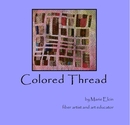Both my Stitch and Surface class and Silkscreen on Fabric class at Fleisher produced a huge quantity of printed fabrics this week.
My Silkscreeners got to be guinea pigs as I attempted to teach deconstructed dye printing. I was inspired by artist Dianne Koppisch Hricko to try this out. Last week I mixed up some sodium alginate, we added dye, and then painted or texturized the screens with dye paste. My crew really like image more than pattern, so they were more like monoprints, but one person attempted a repeat (above), while others just printed their images twice.
In the boat print above the left image was printed first and the right image was printed second after doing a flood stroke and letting the brown dye moisten a bit. In the tree image below, the right side was printed first, then the left. The beauty of deconstructed dye print is that the dye applied to the screen first and left to dry acts as a resist at first, but then as the dye moistens it breaks down and becomes printed as well. Some people went back in with some color to connect a repeat or unify an image.
Below is the screen after it was printed, showing only remnants of the "tree" painting that was on it at first. Another thing I LOVE about dye printing like this is that you can leave the dye in the screen to dry and still be able to wash it out- can't do that with pigment ink without ruining your screens!!! The only thing I'm concerned about is that my sodium alginate print paste mixture might be too thin, and our soda soaked fabric might not take the dye as well as I hope. We don't have a steamer, so we're batching the dye.
My stitch and surface class got to do their "surface design" technique this week. I brought in some weatherstripping adhesive foam and we created our own stamps with it.
Some people used wood blocks, others balsa wood rectangles, and others cardboard squares. Some people brought in adhesive backed craft foam to use as well, which allowed them to cut out motifs instead of just using the rectilinear weatherstripping.
We rolled fabric paint out onto plexiglass plates, then used the brayer to apply paint on the block. I hauled our fabric printing boards up from the silkscreen studio so we would have a soft surface to press into.
There was great experimentation with repeating and overlapping:
Some people explored color shifts and printing over pre-existing patterns:
The metallic fabric paints look fabulous:
Once block-printing was finished, a few students even tried out monoprinting by placing strings over the rolled out inks on the plexi plates:
I loved introducing my students to all these easy printmaking techniques. You can do so much with very little equipment or supplies. As I have some teachers in the group, I hope they'll be inspired to try these out with kids as well. (Well, maybe not the dye stuff, but definitely the block printing!!)
PS: my birthday was this week, and to have this much fabulousness going on in my classrooms was a great present!
Subscribe to:
Post Comments (Atom)















These are wonderful! I can't tell you how much I wish I could take this class with you. I'm very interested in printing on fabric. This is inspirating me to no end.
ReplyDeleteThanks Olisa! Although it's not a "tutorial" exactly, I hope it looks easy enough to try yourself. I keep thinking I'm going to do surface design at home, but I never get to it- so I love doing the demos and experimenting alongside my students.
ReplyDelete